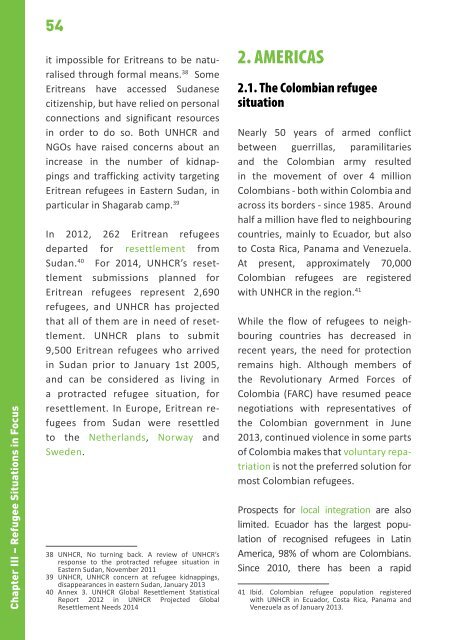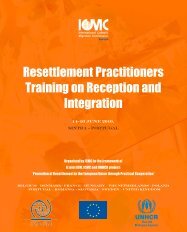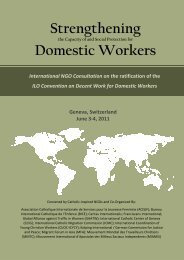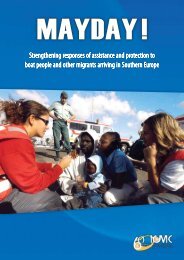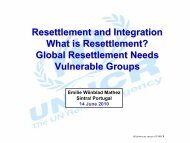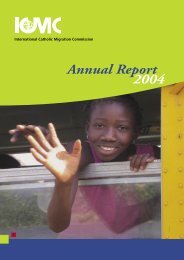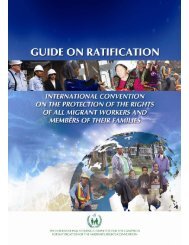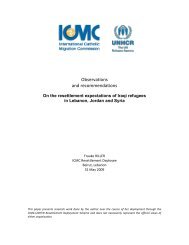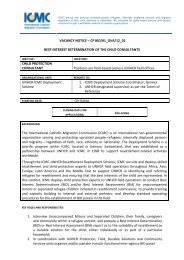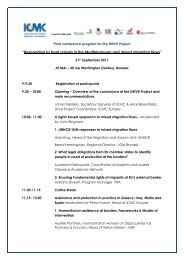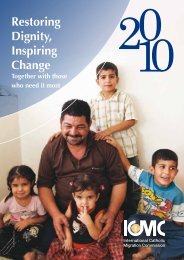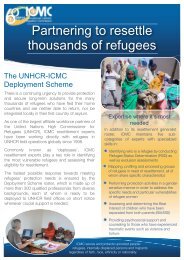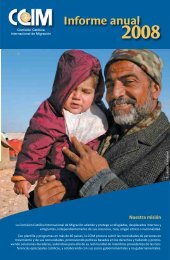ICMCEUROPE WelcometoEurope.pdf (5.89 MB)
ICMCEUROPE WelcometoEurope.pdf (5.89 MB)
ICMCEUROPE WelcometoEurope.pdf (5.89 MB)
Create successful ePaper yourself
Turn your PDF publications into a flip-book with our unique Google optimized e-Paper software.
Chapter III – Refugee Situations in Focus<br />
54<br />
it impossible for Eritreans to be naturalised<br />
through formal means. 38 Some<br />
Eritreans have accessed Sudanese<br />
citizenship, but have relied on personal<br />
connections and significant resources<br />
in order to do so. Both UNHCR and<br />
NGOs have raised concerns about an<br />
increase in the number of kidnappings<br />
and trafficking activity targeting<br />
Eritrean refugees in Eastern Sudan, in<br />
particular in Shagarab camp. 39<br />
In 2012, 262 Eritrean refugees<br />
departed for resettlement from<br />
Sudan. 40 For 2014, UNHCR’s resettlement<br />
submissions planned for<br />
Eritrean refugees represent 2,690<br />
refugees, and UNHCR has projected<br />
that all of them are in need of resettlement.<br />
UNHCR plans to submit<br />
9,500 Eritrean refugees who arrived<br />
in Sudan prior to January 1st 2005,<br />
and can be considered as living in<br />
a protracted refugee situation, for<br />
resettlement. In Europe, Eritrean refugees<br />
from Sudan were resettled<br />
to the Netherlands, Norway and<br />
Sweden.<br />
38 UNHCR, No turning back. A review of UNHCR’s<br />
response to the protracted refugee situation in<br />
Eastern Sudan, November 2011<br />
39 UNHCR, UNHCR concern at refugee kidnappings,<br />
disappearances in eastern Sudan, January 2013<br />
40 Annex 3. UNHCR Global Resettlement Statistical<br />
Report 2012 in UNHCR Projected Global<br />
Resettlement Needs 2014<br />
2. AMERICAS<br />
2.1. The Colombian refugee<br />
situation<br />
Nearly 50 years of armed conflict<br />
between guerrillas, paramilitaries<br />
and the Colombian army resulted<br />
in the movement of over 4 million<br />
Colombians - both within Colombia and<br />
across its borders - since 1985. Around<br />
half a million have fled to neighbouring<br />
countries, mainly to Ecuador, but also<br />
to Costa Rica, Panama and Venezuela.<br />
At present, approximately 70,000<br />
Colombian refugees are registered<br />
with UNHCR in the region. 41<br />
While the flow of refugees to neighbouring<br />
countries has decreased in<br />
recent years, the need for protection<br />
remains high. Although members of<br />
the Revolutionary Armed Forces of<br />
Colombia (FARC) have resumed peace<br />
negotiations with representatives of<br />
the Colombian government in June<br />
2013, continued violence in some parts<br />
of Colombia makes that voluntary repatriation<br />
is not the preferred solution for<br />
most Colombian refugees.<br />
Prospects for local integration are also<br />
limited. Ecuador has the largest population<br />
of recognised refugees in Latin<br />
America, 98% of whom are Colombians.<br />
Since 2010, there has been a rapid<br />
41 Ibid. Colombian refugee population registered<br />
with UNHCR in Ecuador, Costa Rica, Panama and<br />
Venezuela as of January 2013.


